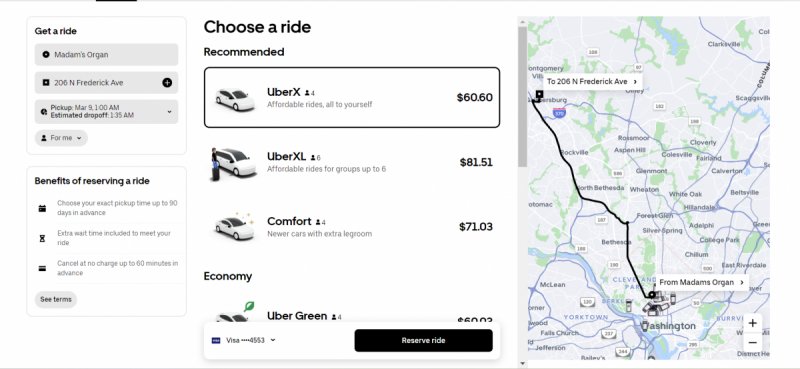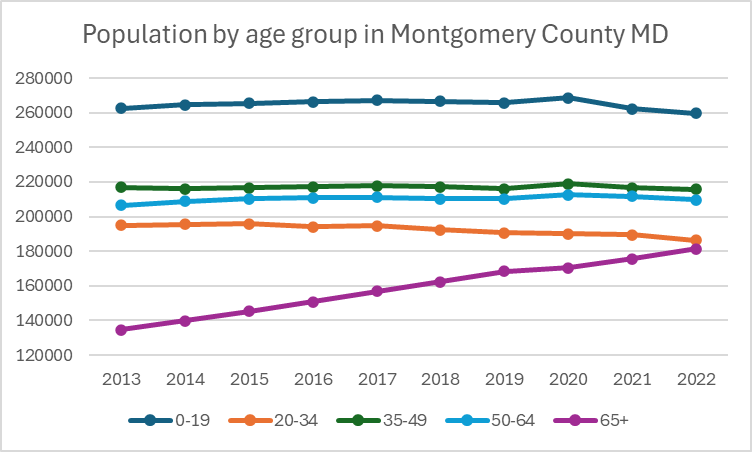Where’s the nightlife in Montgomery County?

Photo by Mike Maguire on Flickr used with a Creative Commons license.
Eleven years ago, Montgomery County formed the Nighttime Economy Task Force to address a demographic crisis: young people were not moving to the county due to its weak nightlife options. Between May and October of 2013, the nineteen-member task force, with the assistance of four county staff members, 11 ex officio members and 20 public sector partners, met 15 times to determine how best to improve the county’s weak nighttime economy. A 60-page report was released, with 32 recommendations, many of which were passed. (Full disclosure: GGWash regional policy director Dan Reed was a member of the task force.)
And yet, here we are eleven years later, with no dance clubs, few late-night spots, and little evidence to suggest that the perception of the county as a social desert for singles has changed. The reason is simple. The five-member board of license commissioners won’t allow it. The Board of License Commissioners is solely responsible for creating the county’s alcohol rules and regulations, and have created a series of regulations seemingly designed with the sole intention of preventing any venue catering to young, single, or recently transplanted people to open in the county. They’ve done so by:
- Requiring that venues obtain 40% of their food and alcohol revenue through food sales (5.6a)
- Requiring that food is available for sale at all times that alcohol is served (5.6d)(5.8)
- Further requiring that this food “consists of a variety of hot and cold meals that are offered on a printed menu” and that this food requirement does not include snack food (5.8)
- Requiring venues to provide enough lighting to read a printed menu in every portion of the premise (5.16)
- Prohibiting dancing in venues that have not obtained an enterprise license(6.14)
- Prohibiting dancing in venues that do not also provide enough tables and seats to meet the definition of a restaurant (6.14)
The impossibility of running a financially viable nightlife business catering to young people under these terms should be apparent. Serving hot food requires a kitchen and kitchen staff. This raises labor costs, raises the costs of goods sold, and lowers the available space for patrons, which increases rental overhead or caps revenue. These costs are not trivial, as successful restaurants can expect a 3-9% profit margin, as opposed to the 10-15% that bars typically see.
These businesses often spend tens to hundreds of thousands of dollars to make sure that the combination of lighting, sound and décor facilitate the kinds of social interactions their patrons expect. These design decisions can have a dramatic impact on not only the logistics of operations, but also the establishment of a venue as a space for social interaction.
The Task Force identified that their rules were preventing bars, taverns, night clubs and entertainment venues from moving to the county and recommended a new social venue license that would bypass these requirements. However, the social venue license was never created. The impact has been dramatic.
Why people cant just take an Uber or bus to the bar
To explore the true costs that the county’s nightlife regulations are imposing, lets consider the following hypothetical - a Gaithersburg resident wants to meet up with her friends at 9:00 to go dancing in Adams Morgan, which for the overwhelming majority of Montgomery County residents is the closest nightlife district. Our poor Gaithersburg resident’s trip only gets worse if she or her friends decide to go dancing in U Street, H Street, Clarendon, or any other nightlife district.
If she decides to take public transportation, the time investment is substantial, and the closing times of metro and many bus routes create a de facto curfew. Assuming she wanted to be at the bar by 9:00 pm she would need to leave her home at 7:21 pm.
How to get from Gaithersburg to Adams Morgan by transit on a Friday night. Image by the author using Google Maps. 
Metro closes at 1:00 on Fridays and Saturdays, however if she leaves that late the bus will not take her home until six, so realistically she needs to leave at 12:30 so she can get to Gaithersburg at 2:00 am.
Getting home by transit. Image by the author using Google Maps. 
By the time she goes to bed, she would have spent approximately three hours, or a little over 45% of her trip on public transit. If she does not live near a bus stop that provides late night service, she will need to walk or bike, at approximately 2:00 in the morning, to her home.
How to get from Gaithersburg to Adams Morgan by Uber on a Friday night. Image by the author using Google Maps. 
Instead, she might decide to take a rideshare service such as Lyft or Uber instead. To get to Adams Morgan, assuming she scheduled ahead of time, she would need to spend approximately $45,
Getting home by Uber. Image by the author using Google Maps. 
and to get back, assuming she scheduled ahead of time and she wanted to leave at 1:00, she would need to spend around $60.00. Assuming she plans on going out once a week, and doesn’t go further in to DC than Adams Morgan, she will have spent around $400 a month on transportation to and from bars, or ¼ the cost of a studio apartment in the county.
The county’s government is aware of the problem; it’s unclear why they’re not doing anything about it
On October 9, 2023, Bill Tompkins, president and CEO of the Montgomery County Economic Development Corporation Maryland, calmly explained to the county council why, in 2021, Boston Consulting Group moved out of their office above the Bethesda Metro to a 98,000 square foot office across from the National Mall.
“We knew about [their move] three years ago,” he said “That is not a housing issue, and it is really about the fact their staff is getting younger and its about lifestyle. So they choose to be closer to where they perceive the action to be[…] (t)hey took a poll of their staff, and as they get younger the overwhelming majority wanted to be where they thought things are happening.”
The response from Natali Fani-Gonzalez, District 6 councilmember and chair of the Economic Development Committee was, “That younger work force you were just talking about, just wait until they have babies. They’ll come back.”
Montgomery County population over time by age group. Image by Montgomery Planning.
With the exception of those over the age of 65, every age demographic group in Montgomery County has seen a decline in their numbers since the pandemic. We can’t blame the pandemic alone for our decline, though, as the county has been shedding 20-34 year olds for the last decade, and 35-49 year olds for the last two. This prolonged flight of young people is likely a contributor to the 25,000 jobs that have left Montgomery County since 2019.
Household composition in Montgomery County by decade. Image by Montgomery Planning.
The traditional assumption behind much of our public policy–that young people will live in the city until they are ready to start a family–has not been true in Montgomery County for decades. Thirty-one percent of the county’s households are single people, indicating that the county has no problem attracting young singles, but it’s remained stable even as today’s youth are more likely to be single than previous generations were at the same age.
However, even if Montgomery County was attractive to young families, a policy of “waiting until they have babies” is a terrible economic strategy. It contributes to our massive labor shortage, which forces employers to eliminate positions, as the county itself did last year, or move to where they can find people to fill these positions. This exacerbates Montgomery County’s well-documented issue growing its economy over the last two decades. Residents with disposable income move out, and are replaced with lower-income residents. Those who choose to stay are increasingly taxed to meet the needs of an aging population.
While the pandemic and its corresponding office closures could not have been predicted ten years ago, the looming demographic crisis the county is facing was explicitly the reason the Nighttime Economy Task Force was created. Two of the eleven current county council members (Evan Glass and Will Jawando) were task force members. County Councilmember Gabe Albornoz was one of four county staff members assigned to the task force. Current County Executive (and then-councilmember) Marc Elrich served as an ex officio member. Kathie Durbin, the director of Montgomery County Alcoholic Beverage Services (formerly the Department of Liquor Control) specifically recommended creating a social venue license. They should all be familiar with this issue.
It’s unclear why, despite being widely popular, revenue positive, vital to economic growth, and critical to fostering healthy social connections, the social venue license was never created. In writing this article I’ve reached out to several members of the task force to ask this very question and not surprisingly no one wants to take responsibility for killing dating and dancing in Montgomery County. We’ll probably never know why a social venue license was not created ten years ago. However, we can demand that the board of license commissioners create one now before we lose out on another generation of revenue, growth, love, and friendship.
